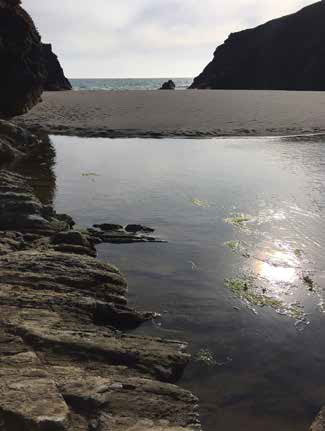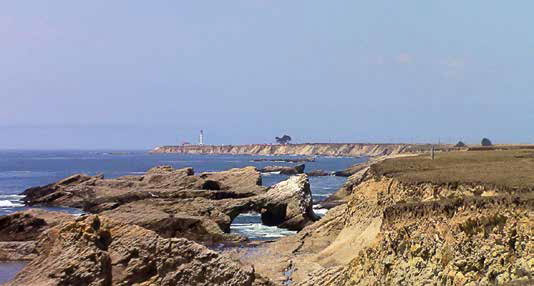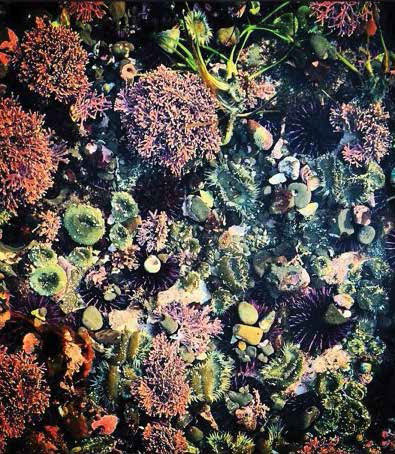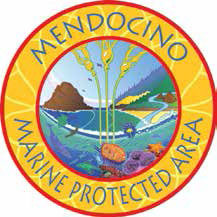Marine Protected Areas
(MPA Collaboratives)

Hearn Gulch Beach
Credit: Susan E. Moon
This year RCLC has assisted the California Marine Protected Area Collaborative Implementation Project by participating in the Mendocino MPA Collaborative. RCLC stewards Hearn Gulch, which is adjacent to Saunders Reef MPA. This summer, our Vice President, Susan Moon, volunteered her illustration skills to the Collaborative by helping design and produce a fold out pocket guide to the Mendocino MPAs, and by creating a logo for the group.
“It was Mendocino Area Parks Supervisor, Loren Rex, who came up with the idea to have an abalone character prominent in the design. I tried to integrate the major stakeholders including fishing, science, law enforcement, Native Americans and the unique environments of the Mendocino County MPAs. The result was more of a seal than a logo, but everyone seemed happy with it so we went with the design to represent the group,” says Moon.
Projects of the Collaborative include a uniformed officer training program and marine protected area outreach and education to be provided to schools, councils, clubs and associations in Mendocino and Lake Counties. Part of the group’s mission is to create effective, transparent, grassroots stewardship of California’s marine protected areas. The Collaborative has installed signs in several key locations along the coast to assist the public and law enforcement in identifying MPA boundaries from land.

The waters off Hearn Gulch are in the center of the Saunders Reef State Marine Conservation Area, an impressive rocky reef and bull kelp habitat.
Credit: Laurie Mueller
California Coastal National Monument
RCLC has been an active official partner working with the Point Arena Gateway Group of the California Coastal National Monument (CCNM) for several years now. Partners in this group include the Point Arena-Manchester Band of Pomo Indians, Mendocino Audubon Society, California Native Plants Society, Acorn Partners in Education, the City of Point Arena, to name just a few. The United States Bureau of Land Management manages the land and is in the process of amending the Resource Management Plan.
“It has been so interesting working with BLM staff, from planners to biologists, archeologists to rangers to conserve and envision the future of these lands. Of utmost importance to me personally is the protection of the lands, which is balanced by interests of the various user groups,” says volunteer RCLC Board of Directors vice president, Susan Moon who attends Gateway Group meetings, and is chairing a subcommittee studying trails on the 1,065 acre National Monument. “The management plan amendments will help to ensure protections and management protocols that are needed for the land based portion of the CCNM. The Point Arena -Stornetta Unit was not previously included in the original management plan which is specific only to rocks and islands off the coast.”
We look forward to RCLC’s continued participation with the Point Arena Gateway group and are thrilled to be part of the protection of this beautiful and important landscape.

Point Arena-Stornetta Unit of the California Coastal National Monument
Credit: Adam I. Brown
RCLC Joins New Marine Sanctuary Advisory Group
RCLC’s new collaboration is with a new local advisory group to the Greater Farallones Association. As you know, the Gulf of the Farallones and Cordell Bank National Marine Sanctuaries were expanded north all the way to the 39th parallel at Alder Creek in Manchester, making Mendonoma an important region in relation to what is now the Greater Farallones National Marine Sanctuary. Advisory group participants from Sonoma and Mendocino Counties provide counsel to the staff, the board of directors and the constituents of the Greater Farallones Association on all activities in the region, including – education, monitoring and citizen science programs, advocacy, community outreach and fundraising. Margaret Lindgren, owner of Unbeaten Path Hiking Tours and a resident of The Sea Ranch, is acting Chair of the Advisors and was recently elected to the Association’s Board of Directors to provide a voice for the region in Association activities and plans now and in the future.
 RCLC’s Linda Bell and Susan Moon have been recruited as inaugural members to the advisory group to strengthen relationships with non-profits in the area and with constituents in the Manchester/Alder Creek Region.
RCLC’s Linda Bell and Susan Moon have been recruited as inaugural members to the advisory group to strengthen relationships with non-profits in the area and with constituents in the Manchester/Alder Creek Region.
Reefs in the Marine Sanctuary contain a rich diversity of sea life.
Credit: Monika Krach, GFA

